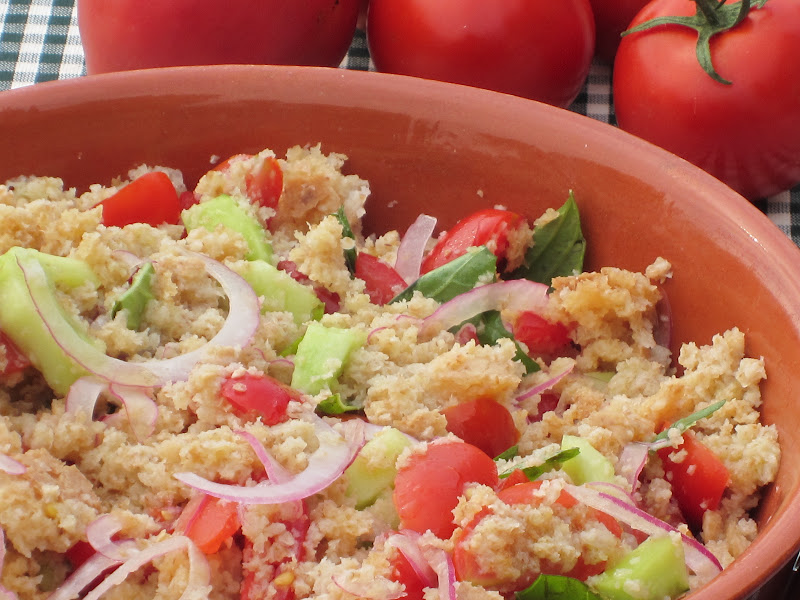La Panzanella Posted by Serena on Aug 12, 2016 in Uncategorized
Browsing through my mother’s cookery books, I found an old booklet containing traditional Tuscan recipes. As I started reading through it I was immediately struck by its language, a beautifully old style Tuscan, full of almost obsolete words.
So I decided to copy one of the recipes and share it with you. I chose La Panzanella because it’s a refreshing summer dish, just perfect for a hot August’s day in Italy. Here its is …

Occorrente per 6 persone:
12 fette di pane casereccio scuro e raffermato; olio extravergine di oliva; 200 grammi di pomodori; basilico; 1 cipolla; sale e pepe.
Ingredients for 6 people:
12 slices of rustic dark stale bread; extra virgin olive oil; 200 grams of tomatoes; basil; 1 onion; salt and pepper.
La panzanella è un piatto poverissimo, umile, ma fragrante; si usa soltanto in Toscana, specie nel senese. La ricetta? Eccola.
Panzanella is a very poor, humble, but fragrant dish; it’s only served in Tuscany, especially around Siena. The recipe? Here it is.
Ci vuole pane campagnolo, fatto con grano macinato a pietra, un po’ bigio, cotto nel forno a legna.
You’ll need country style bread, made with stone ground flour, a bit grey, baked in a wood fired oven.
Mettete per qualche minuto a bagno nell’acqua (acqua di pozzo, recita la ricetta) il pane tagliato a fette, poi sgrondatele in un panno: il segreto sta nel regolarsi in modo che le fette di pane si sbriciolino senza trasformarsi in pappa, capito?
Put the sliced bread in water (water from a well, the recipe prescribes) for a few minutes, then get rid of the water by shaking the bread in a tea-towel: the secret is to regulate it so that the slices crumble without turning into mush, understood?
Il tocco successivo consiste nel condire il pane con olio, sale e pepe. Ultima misura: mescolare il tutto con un trito di pomodori, basilico e cipolla.
The next ‘touch’ consists in dressing the bread with oil, salt and pepper. Last measure: mix the whole lot with finely chopped tomatoes, basil and onion.
Si serve freddissima (c’è addirittura chi la tiene per qualche ora nel frigorifero).
It’ s served very cold (some people even keep it in the fridge for a few hours).
Variations: You can add other fresh summer vegetables such as cucumber or finely chopped wild chicory. Some people also add a dash of vinegar.
N.B. In the last few years La Panzanella has enjoyed a revival and is now a common refreshing summer dish in many parts of Italy. However, despite its simplicity (or rather due to its simplicity), in order to make a tasty, pleasant dish you must choose the right type of bread. Several times I’ve been given this dish by non-Tuscan people who didn’t know the secret, and the result was always the same: a big squishy bowl of porridge!
Allora: it’s important to use un pane a lievitazione naturale (a bread made with natural yeast), possibilmente cotto a legna (possibly baked in a wood fired oven). This will ensure that the bread, once wet, will crumble without turning into a soggy pulp, capito?
Buon Appetito!

Build vocabulary, practice pronunciation, and more with Transparent Language Online. Available anytime, anywhere, on any device.




Leave a comment: